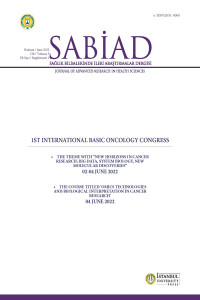DISCOVERY OF NOVEL EPIGENETIC BIOMARKERS IN ORAL MALIGNANT LESIONS BY EPIGENOMICS AND TRANSCRIPTOMICS APPROACHES
Abstract
Objectives: DNA methylation, which is the most frequently observed epigenetic change, is very important because it is seen in the early stages of cancer. Abnormal methylation of promoter regions and silencing of tumor suppressor genes play a key role in the development of oral squamous cell carcinoma (OSCC). In our study*, it was aimed to identify and validate new biomarker candidates via epigenomics/transcriptomics approaches, to understand the molecular mechanisms of OSCC and to discover new biomarkers for early diagnosis. Materials and Methods: After DNA/RNA isolation of tumor/matched-normal tissue samples from 6 OSCC patients, BC-DNA/cDNA synthesis was performed, respectively. The methylation and expression profiles were analyzed by the R(v3.5.1) environment methods using IlluminaHumanMethylation450chips and IlluminaiScan, respectively. A candidate gene showing methylation-dependent expression loss after bioinformatic analysis was validated by QRT-PCR AND QMSP methods in tissues and body fluids of 20 OSCC and 20 oral premalignant lesions (OPML) patients, respectively. Results: To identify epigenetic biomarker candidate, we selected gene which show either hypermethylation and lower expression patterns. This candidate gene (unpublished data), which is belong subfamily of the protein-tyrosine kinase, was found to be methylated in 65% of tumors, 20% of matched-normal tissues of OSCC. The methylation rates of the candidate gene in tumor, matched-normal tissues and saliva of OPML patients were found to be 55%, 40% and 10%, respectively. The decreased expression levels of candidate gene were observed in 55% OSCC and 35% OPML tumors, respectively. Conclusions: Our candidate gene could be a biomarker for early detection of OSCC.
Keywords
Supporting Institution
TUBITAK
Project Number
TUBITAK-SBAG-114S497
References
- Dela Cruz CS, Tanoue LT, Matthay RA. Lung cancer: epidemiology, etiology, and prevention. Clin Chest Med. 2011;32(4):605-44.
DISCOVERY OF NOVEL EPIGENETIC BIOMARKERS IN ORAL MALIGNANT LESIONS BY EPIGENOMICS AND TRANSCRIPTOMICS APPROACHES
Abstract
Objectives: DNA methylation, which is the most frequently observed epigenetic change, is very important because it is seen in the early stages of cancer.
Abnormal methylation of promoter regions and silencing of tumor suppressor genes play a key role in the development of oral squamous cell carcinoma
(OSCC). In our study*, it was aimed to identify and validate new biomarker candidates via epigenomics/transcriptomics approaches, to understand the
molecular mechanisms of OSCC and to discover new biomarkers for early diagnosis.
Materials and Methods: After DNA/RNA isolation of tumor/matched-normal tissue samples from 6 OSCC patients, BC-DNA/cDNA synthesis was
performed, respectively. The methylation and expression profiles were analyzed by the R(v3.5.1) environment methods using
IlluminaHumanMethylation450chips and IlluminaiScan, respectively. A candidate gene showing methylation-dependent expression loss after bioinformatic
analysis was validated by QRT-PCR AND QMSP methods in tissues and body fluids of 20 OSCC and 20 oral premalignant lesions (OPML) patients,
respectively.
Results: To identify epigenetic biomarker candidate, we selected gene which show either hypermethylation and lower expression patterns. This candidate
gene (unpublished data), which is belong subfamily of the protein-tyrosine kinase, was found to be methylated in 65% of tumors, 20% of matched-normal
tissues of OSCC. The methylation rates of the candidate gene in tumor, matched-normal tissues and saliva of OPML patients were found to be 55%, 40%
and 10%, respectively. The decreased expression levels of candidate gene were observed in 55% OSCC and 35% OPML tumors, respectively.
Conclusions: Our candidate gene could be a biomarker for early detection of OSCC.
Keywords
Project Number
TUBITAK-SBAG-114S497
References
- Dela Cruz CS, Tanoue LT, Matthay RA. Lung cancer: epidemiology, etiology, and prevention. Clin Chest Med. 2011;32(4):605-44.
Details
| Primary Language | English |
|---|---|
| Subjects | Clinical Sciences |
| Journal Section | Meeting Abstract |
| Authors | |
| Project Number | TUBITAK-SBAG-114S497 |
| Publication Date | August 9, 2022 |
| Submission Date | July 18, 2022 |
| Published in Issue | Year 2022 Volume: 5 Issue: S-1 |


